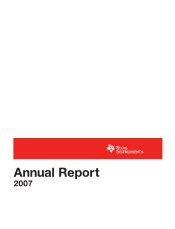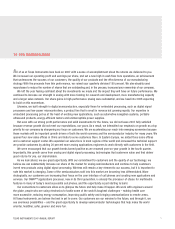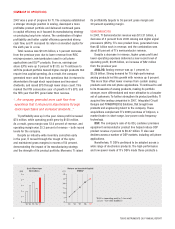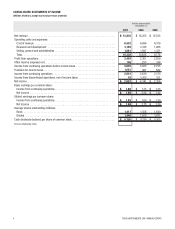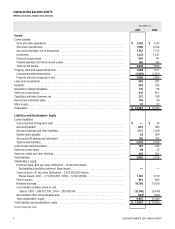Texas Instruments 2007 Annual Report Download - page 6
Download and view the complete annual report
Please find page 6 of the 2007 Texas Instruments annual report below. You can navigate through the pages in the report by either clicking on the pages listed below, or by using the keyword search tool below to find specific information within the annual report.
TEXAS INSTRUMENTS 2007 ANNUAL REPORT
4
CEO Q&A:SPOTLIGHT ON TI’S STRATEGY
Q: TI grew profit last year, although not revenue. How do
you view the role of revenue growth in TI’s strategy?
A: Revenue growth, especially in the right areas, is
fundamental to our strategy. I believe the most important
driver of future growth will be analog. It’s a large market,
and small share gains translate into hundreds of millions
of dollars of growth. Wireless remains important as
applications processors become an increasingly
significant tool for customers to deliver a better user
experience. Finally, DSP helps us unlock new growth
markets as customers innovate in diverse areas like
public safety, medical and automotive.
Q: Why such enthusiasm for analog?
A: With nearly every electronics device in the world
requiring analog, this market is $36 billion and growing.
TI is the market leader in analog, and even though we’ve
expanded that lead over the past few years, we only
have about 13 percent share. That means we have
plenty of room to grow. Our investments in analog over
the last decade, including several acquisitions of
companies, are bearing fruit with a larger, improved
and more profitable product portfolio and more differenti-
ated manufacturing process technologies.
Q: What about DSP?
A: We were a pioneer in this technology, and digital signal
processing will continue to play a significant role in our
future growth. We’re seeing the emergence of a broad,
rich set of new products and applications with exciting
potential for growth, like security and surveillance,
automotive navigation and more energy-efficient motor
drives. As our customers innovate their own products
by writing software that runs on our processors, our
relationships with these customers are usually long-
lasting and strategic, often spanning multiple generations
of their products.
Q: How is wireless changing?
A: There’s a lot of change underway in today’s wireless
market. Modems, which connect the handset to the
network, are becoming more standardized and the
market for these products is becoming more competi-
tive. As a result, customers are increasingly adopting
these off-the-shelf products and are redirecting more
of their own R&D investments to create more user-
friendly interfaces and provide consumers with more
and better mobile applications. These smartphones are
fast becoming the most important segment of the
wireless market. TI’s OMAP applications processors
already have the lead in this market, and I’m excited
about the opportunity for TI to play an even greater role
in our customers’ success. Our expertise in mobile
multimedia processing lies at the center of our wireless
strategy going forward.
Q: What has been the impact of your manufacturing
strategy?
A: Our hybrid model, combining support from third-party
foundry manufacturers with TI’s internal manufacturing
for advanced digital processess, gives us greater
flexibility to respond faster to shifts in customer demand
while minimizing the fluctuations in our own factory
loadings. This also allows us to focus more of our
manufacturing resources on analog, where asset lives are
long and returns are high. The net result is that declining
demand doesn’t hurt our profitability as much as it did in
the past. We have also been able to reduce our capital
spending from the levels needed to support an internal-
only manufacturing model. The result is better customer
support – plus higher capital efficiency, cash flow and
return on invested capital.
Q: What opportunities do you see on the horizon?
A: Analog and DSP technology will be key to helping our
customers solve some of the major problems facing
society today: affordable, available health care; more-
efficient use of energy; and making our lives safer, to
name a few. I believe medical electronics will emerge
to become one of the great growth markets for
semiconductors in the next decade. By leveraging TI’s
expertise in imaging, low power and wireless, customers
today are designing products like life-saving portable
defibrillators and high-quality imagers, which provide
physicians with the capability for highly accurate and
non-invasive diagnostics. Further out on the horizon,
we see significant opportunities for medical electronic
devices that will be implanted in human bodies, as
well as products that will aid in remote health care or
home-based monitoring systems, helping bring quality
medical services to more people around the world.

